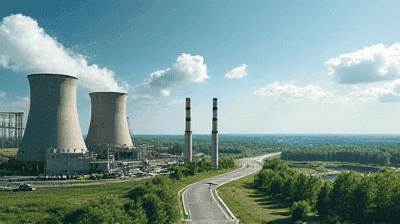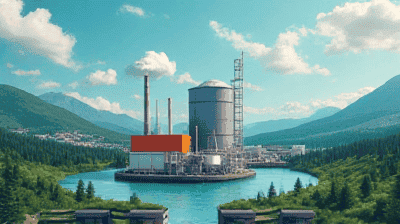
In the struggle against climate change, carbon dioxide emissions are a major contributor to global warming and environmental degradation. The need for effective methods to mitigate these emissions has never been more urgent. Among the promising solutions being developed, Carbon Capture and Storage (CCS) stands out as a crucial technology for securing a sustainable future.
Carbon dioxide (CO2) is a greenhouse gas that traps heat in the Earth's atmosphere. Fossil fuel combustion for energy production, transportation, and industrial activities releases vast amounts of CO2, contributing significantly to the greenhouse effect. This leads to global warming, extreme weather events, rising sea levels, and adverse impacts on ecosystems and human health.
The primary sources of carbon emissions can be categorized as follows:
Energy Production: The burning of coal, oil, and natural gas for electricity and heat is the largest single source of global CO2 emissions.
Transportation: Vehicles powered by gasoline and diesel fuel contribute significantly to air pollution and carbon emissions.
Industrial Processes: Manufacturing industries, including cement, steel, and chemical production, release substantial amounts of CO2 during their operations.
Agriculture and Land Use: Deforestation, land-use changes, and agricultural practices such as livestock production contribute to CO2 emissions and reduce the Earth's capacity to absorb carbon.

Carbon Capture and Storage involves capturing carbon dioxide emissions produced from industrial processes and storing it underground to prevent it from entering the atmosphere. CCS can be applied to power generation plants, industrial facilities, and even bioenergy production.
The CCS process typically consists of three main stages:
Capture: This involves the separation of CO2 from other gases emitted during industrial processes or power generation. Different technologies can be used for capture, including:
Transport: Once captured, carbon dioxide needs to be transported to a storage site. This can be done using pipelines, trucks, or ships, depending on the scale and distance involved.
Storage: The final stage involves storing the captured CO2 in geological formations, such as depleted oil and gas reservoirs, deep saline aquifers, or unmineable coal seams. The aim is to ensure that the CO2 remains securely contained for thousands of years.
The efficiency of carbon capture depends on the technology used. Here are the most common methods in more detail:
Absorption: This widely used technique employs chemical solvents to capture CO2 from flue gases. For example, amine solutions react with CO2, resulting in a compound that can be processed to release pure CO2.
Adsorption: This method involves using solid materials to trap CO2 from flue gases. Adsorbents, such as zeolites and activated carbon, can capture CO2 at low concentrations and release it at higher temperatures.
Membrane Separation: Membrane technology uses selective barriers to separate CO2 from other gases. Membranes can be designed to allow CO2 to pass through while blocking other gases, making it a promising alternative for carbon capture.
Cryogenic Separation: This process involves cooling the gas stream to low temperatures to liquefy and separate the CO2 from other gases. While effective, it is energy-intensive and typically used in large-scale applications.
Several factors influence the efficiency of carbon capture technologies:
Gas Composition: The concentration of CO2 in the gas stream affects the capture process. Higher concentrations generally lead to more efficient capture.
Temperature and Pressure: The physical properties of gases change with temperature and pressure, which can impact the performance of capture technologies.
Operating Conditions: The design and operation of the capture systems, including the flow rates and equipment configurations, play a crucial role in overall efficiency.
Ongoing research is focused on improving the efficiency and affordability of carbon capture technologies. Key areas of investigation include:
Innovative Solvents: Developing new chemical solvents that are more effective at capturing CO2 while requiring less energy for regeneration.
Low-Cost Materials: Exploring new adsorbent materials that are cheaper, more abundant, and more effective for carbon capture.
Process Optimization: Continuing to fine-tune existing technologies to maximize their performance and minimize energy consumption.

Pipelines are typically the most efficient means of transporting CO2 overland. These pipelines can transport CO2 from capture sites to storage locations, allowing for large-scale transport of the gas.
Infrastructure Development: Investing in pipeline infrastructure is crucial for a successful CCS program. To date, pipeline networks are more developed in regions with significant industrial activities, such as North America and Europe.
Regulatory Considerations: The transportation of CO2 is subject to various regulations and safety standards to prevent leaks and ensure safe operation.
For regions where pipeline infrastructure is not feasible, transporting CO2 by ship or truck may be appropriate. While these methods can be more costly, they provide flexibility to transport captured CO2 to storage sites.
Ensuring the safety of CO2 transport is a critical consideration. Preemptive measures include:
Monitoring and Maintenance: Regular inspections of pipelines and transport vehicles to detect leaks or corrosion.
Emergency Response Planning: Establishing protocols in case of leaks or accidents, including rapid-response teams and community notifications.
The successful long-term storage of CO2 relies on identifying suitable geological formations. Common types of storage sites include:
Depleted Oil and Gas Fields: These sites are often ideal for storage as they have previously contained hydrocarbons and offer information on the geological characteristics that can contain CO2.
Deep Saline Aquifers: Saline formations located deep underground possess high porosity and permeability. These formations can efficiently store large volumes of CO2.
Unmineable Coal Seams: CO2 injection into coal seams can enhance methane recovery while storing carbon, making this a dual-benefit approach.
To ensure the security of CO2 storage, monitoring and verification methods are essential. These include:
Seismic Monitoring: Techniques that allow scientists to track the movement of fluids within the geological formations.
Pressure and Temperature Monitoring: Observing changes in pressure and temperature can provide insights into the storage site’s integrity.
Well Integrity Assessments: Regular checks to ensure that wells do not become pathways for CO2 leakage.
While geological storage is considered safe, potential environmental impacts must be assessed. Risks include:
Leakage: The possibility of CO2 leaking back to the atmosphere, which could negate the benefits of capture and storage.
Induced Seismicity: The injection of CO2 into geological formations may alter pressure conditions, potentially triggering minor earthquakes.
Groundwater Contamination: There is a concern that stored CO2 could migrate into freshwater aquifers, affecting water quality.

The most significant benefit of CCS is its potential to mitigate climate change:
Reduction of CO2 Emissions: CCS can significantly reduce the amount of CO2 released into the atmosphere from power plants and industries.
Supporting a Low-Carbon Economy: By enabling continued use of fossil fuels while minimizing emissions, CCS can bridge the transition to renewable energy sources.
Job Creation: Developing a CCS industry can create jobs in engineering, construction, and monitoring.
Investment Opportunities: Increased investment in CCS technology can stimulate growth in related sectors, including manufacturing and infrastructure development.
Oil and Gas Sector Benefits: CCS can provide an avenue for oil and gas industries to maintain relevance through enhanced oil recovery while addressing environmental concerns.
Improved Air Quality: By capturing CO2 and reducing emissions from fossil fuel combustion, CCS can contribute to cleaner air and improved public health outcomes.
Reduction of Other Pollutants: Many capture technologies can also reduce other harmful pollutants, such as sulfur dioxide (SO2) and nitrogen oxides (NOx), further benefiting air quality.
High Costs: The initial investment and operational costs for CCS technologies can be significant. Developing economic incentives, such as carbon pricing or government subsidies, may be necessary to encourage adoption.
Financing and Investment: Attracting private investment in CCS projects can be challenging, especially when competing with other renewable energy technologies.
Efficiency and Effectiveness: Current CCS technologies vary in efficiency, and ongoing R&D is essential to improve performance.
Infrastructure Needs: Developing the necessary infrastructure for CO2 transport and storage can be both costly and time-consuming.
Public Acceptance: Building public support for CCS requires ongoing education and transparency regarding its safety and benefits.
Regulatory Frameworks: Developing comprehensive regulatory frameworks that address safety, liability, and environmental impacts is essential for the successful deployment of CCS.
Government Initiatives: Governments can play a crucial role in fostering CCS by providing funding for research, establishing regulatory frameworks, and offering incentives for adoption.
International Cooperation: Addressing global climate change requires collaboration among countries. International partnerships can facilitate the sharing of knowledge, technology, and best practices related to CCS.
Innovative Approaches: Research into alternative methods for carbon capture, such as bioenergy with carbon capture and storage (BECCS) and direct air capture (DAC), can enhance the effectiveness and scope of CCS.
Integration with Renewable Energy: CCS can be combined with renewable energy sources to create low-carbon energy systems, helping to decarbonize various sectors.
Involvement of Industry and Academia: Collaborative efforts among governments, industries, and academic institutions can drive innovation and investment in CCS technologies.
Community Engagement: Engaging communities in the planning and implementation of CCS projects can foster public support and address concerns.
Carbon Capture and Storage represents a vital solution in the fight against climate change and air pollution. By effectively capturing and storing CO2 emissions, CCS has the potential to significantly reduce greenhouse gas concentrations in the atmosphere, thereby contributing to cleaner air and a healthier planet.
While challenges remain in terms of cost, technology, and public acceptance, ongoing research and development, coupled with supportive policies and stakeholder engagement, can pave the way for widespread deployment of CCS technology. As the world continues to grapple with climate change, CCS offers hope for a sustainable future where economic growth and environmental responsibility go hand in hand.